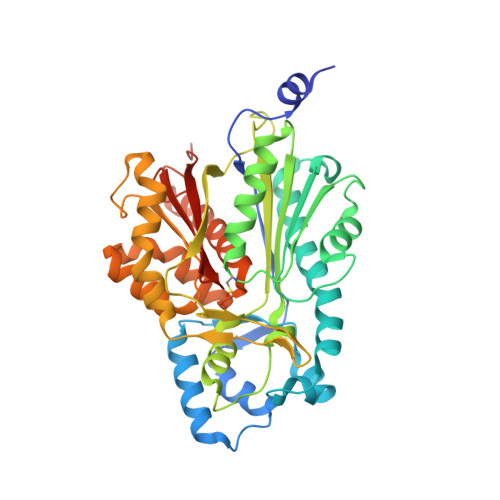Structural and Interactional Analysis of the Flavonoid Pathway Proteins: Chalcone Synthase, Chalcone Isomerase and Chalcone Isomerase-like Protein.
Lewis, J.A., Jacobo, E.P., Palmer, N., Vermerris, W., Sattler, S.E., Brozik, J.A., Sarath, G., Kang, C.(2024) Int J Mol Sci 25
- PubMed: 38891840
- DOI: https://doi.org/10.3390/ijms25115651
- Primary Citation of Related Structures:
8V8L, 8V8M, 8V8N, 8V8O, 8V8P - PubMed Abstract:
Chalcone synthase (CHS) and chalcone isomerase (CHI) catalyze the first two committed steps of the flavonoid pathway that plays a pivotal role in the growth and reproduction of land plants, including UV protection, pigmentation, symbiotic nitrogen fixation, and pathogen resistance. Based on the obtained X-ray crystal structures of CHS, CHI, and chalcone isomerase-like protein (CHIL) from the same monocotyledon, Panicum virgatum , along with the results of the steady-state kinetics, spectroscopic/thermodynamic analyses, intermolecular interactions, and their effect on each catalytic step are proposed. In addition, PvCHI's unique activity for both naringenin chalcone and isoliquiritigenin was analyzed, and the observed hierarchical activity for those type-I and -II substrates was explained with the intrinsic characteristics of the enzyme and two substrates. The structure of PvCHS complexed with naringenin supports uncompetitive inhibition. PvCHS displays intrinsic catalytic promiscuity, evident from the formation of p -coumaroyltriacetic acid lactone (CTAL) in addition to naringenin chalcone. In the presence of PvCHIL, conversion of p -coumaroyl-CoA to naringenin through PvCHS and PvCHI displayed ~400-fold increased V max with reduced formation of CTAL by 70%. Supporting this model, molecular docking, ITC (Isothermal Titration Calorimetry), and FRET (Fluorescence Resonance Energy Transfer) indicated that both PvCHI and PvCHIL interact with PvCHS in a non-competitive manner, indicating the plausible allosteric effect of naringenin on CHS. Significantly, the presence of naringenin increased the affinity between PvCHS and PvCHIL, whereas naringenin chalcone decreased the affinity, indicating a plausible feedback mechanism to minimize spontaneous incorrect stereoisomers. These are the first findings from a three-body system from the same species, indicating the importance of the macromolecular assembly of CHS-CHI-CHIL in determining the amount and type of flavonoids produced in plant cells.
- Department of Chemistry, Washington State University, Pullman, WA 99164, USA.
Organizational Affiliation:



















